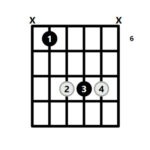The C# Major chord, often written as C sharp major, is a foundational chord for guitarists across various music genres. While it might seem a bit tricky at first due to the sharps, understanding and mastering the C# chord opens up a world of musical possibilities on the guitar. This guide will take you through everything you need to know about playing the C# guitar chord, from basic theory to multiple shapes and practical playing tips.
Delving into C# Major Chord Theory
Before we jump into chord shapes, let’s briefly explore the music theory behind the C# Major chord to enhance your understanding.
- Notes in a C# Major Chord: The C# Major chord is built from three notes: C#, E#, and G#.
- Construction from the C# Major Scale: It’s derived from the 1st, 3rd, and 5th degrees of the C# Major scale. Understanding scales and chords together builds a stronger musical foundation.
- Interval Composition: Like all major chords, the C# Major chord consists of specific intervals from its root note (C#): a Major 3rd, followed by a minor 3rd, and a Perfect 4th to return to the octave root.
- Key of C# Major: The C# Major chord is the very first chord you encounter in the key of C# Major. The complete set of chords in this key are: C#, D#m, E#, F#, G#, A#, and B# diminished.
Understanding these theoretical elements, even at a basic level, can significantly improve your comprehension and application of guitar chords.
10 Essential Ways to Play the C# Major Chord
For those eager to get straight to playing, here’s a visual guide to ten different shapes for the C# Major chord. Chord diagrams are an invaluable tool for guitarists, and these charts provide a comprehensive overview of your options.
 Diagram showing 10 variations of C sharp major chord shapes on guitar fretboard
Diagram showing 10 variations of C sharp major chord shapes on guitar fretboard
The Standard C# Chord Shape: Rooted on the 5th String
The most commonly taught C# chord shape is based on the root-5 barre chord form, positioned at the 4th fret. Often, guitarists will play this shape without fully barring across all strings with their index finger, instead focusing on pressing down the root note and the necessary strings for the chord.
 Illustration of the standard C sharp major chord shape on guitar
Illustration of the standard C sharp major chord shape on guitar
This shape is versatile and frequently used in many songs. It’s a great starting point for mastering the C# chord.
The “Easy” C# Chord Shape: A Simplified Approach
If barre chords feel challenging initially, the “easy” C# chord shape offers a fantastic alternative. This simplified version focuses on the top three strings of the guitar. It’s essentially the same fingering pattern as the open D chord shape but moved up the fretboard by one fret (remember, C# is enharmonically equivalent to Db, which is a half step down from D).
 Image depicting the easy C sharp major chord shape for beginners
Image depicting the easy C sharp major chord shape for beginners
This shape is excellent for beginners and for situations where you need quick chord changes and don’t require the full, rich sound of a barre chord.
Step-by-Step Guide to Playing the Standard C# Major Chord
Let’s break down the standard C# Major chord shape into simple, actionable steps:
- Index Finger Placement: Place your first finger on the 4th fret of the 5th string (A string). This finger often doesn’t need to barre, just press firmly on this string.
- Middle Finger Placement: Position your second finger on the 6th fret of the 4th string (D string).
- Ring Finger Placement: Place your third finger on the 6th fret of the 3rd string (G string).
- Pinky Finger Placement: Put your fourth finger on the 6th fret of the 2nd string (B string).
- Strumming: Avoid strumming the 6th string (low E string). Strum down from the 5th string to the 1st string.
Following these step-by-step instructions can be incredibly helpful, especially when you’re unsure if you’re correctly interpreting a chord diagram. It’s a great way to double-check your finger placement and ensure you’re playing the C# chord accurately.
Utilizing Barre Chords for C# Major
As you progress, barre chords become essential for playing chords all over the guitar neck. The C# chord is readily playable as a barre chord in two primary forms:
- Root 6 Barre Chord Shape: Based on the E Major barre chord shape, position this at the 9th fret to play C# Major.
- Root 5 Barre Chord Shape: Based on the A Major barre chord shape, position this at the 4th fret (as discussed in the “Standard Shape” section).
 Visualization of C sharp major barre chord shapes on the guitar neck
Visualization of C sharp major barre chord shapes on the guitar neck
Barre chords provide a fuller sound and allow you to transition smoothly between chords across the fretboard. Mastering these shapes is crucial for expanding your guitar vocabulary.
Exploring C# Major Triads
Beyond full chord shapes, understanding triads is invaluable for guitarists. Triads are three-note chords that form the foundation of harmony. The C# Major triad can be voiced in three inversions:
- Root Position: C#, E#, G#
- 1st Inversion: E#, G#, C# (E# is the lowest note)
- 2nd Inversion: G#, C#, E# (G# is the lowest note)
Here are diagrams showing six different ways to play C# Major triads across the guitar neck, including these inversions.
 Diagram showing various C sharp major triad positions on a guitar
Diagram showing various C sharp major triad positions on a guitar
Triads are useful for creating lighter textures, melodic lines, and understanding chord voicings in different musical contexts.
Keys Where the C# Major Chord Resides
Knowing which musical keys feature the C# Major chord helps you understand its harmonic function and where it naturally fits within songs. You’ll find the C# chord in these keys:
- C# Major: (C#, D#m, E#m, F#, G#, A#m, B#dim) – Naturally the tonic chord.
- G# Major: (G#, A#m, B#m, C#, D#, E#m, Fxdim) – The subdominant chord (IV chord).
- F# Major: (F#, G#m, A#m, B, C#, D#m, E#dim) – The dominant chord (V chord).
- A# minor: (A#m, B#dim, C#, D#m, E#m, F#, G#) – The relative major’s dominant chord.
- D# minor: (D#m, E#dim, F#, G#m, A#m, B, C#) – The mediant chord (III chord).
Understanding these key relationships allows you to predict chord progressions and write your own music more effectively.
Useful Alternative C# Chord Shapes
While the standard shapes are essential, exploring alternative C# chord voicings can add color and variety to your playing. These shapes might not be as common, but they offer unique sonic textures and can be very useful in specific musical situations.
C# Chord Substitutions: Expanding Your Harmonic Palette
In certain contexts, you can substitute the C# Major chord with related chords to create harmonic interest. Common substitutions include:
- C# sus4 chord: Adds a suspended, unresolved quality.
- C# sus2 chord: Creates a brighter, more open sound.
- C# add9 chord: Adds a jazzy, extended harmony.
Conversely, the C# Major chord itself can often serve as a simpler substitute for more complex chords rooted on C#, such as C# Major 7, C#7, and other extended chords (though it’s not a substitute for minor chords).
Scales for Soloing and Improvising Over the C# Chord
To effectively solo or improvise over a C# Major chord, or to craft melodies for songwriting, consider using these scales:
- C# Major Scale: The most fundamental choice, naturally harmonizes with the chord.
- C# Major Pentatonic Scale: A simpler, five-note scale that works well for melodic improvisation.
- C# Lydian Mode: Adds a brighter, more ethereal quality due to the raised 4th.
Experimenting with these scales will unlock your creative potential when playing over the C# Major chord.
Further Exploration of Guitar Chords
 Image of an eBook cover titled "Get Guitar Chords Galore eBook"
Image of an eBook cover titled "Get Guitar Chords Galore eBook"
To further expand your guitar chord knowledge, consider exploring resources like “Guitar Chords Galore eBook” for a comprehensive guide to chords and playing techniques. Mastering the C

